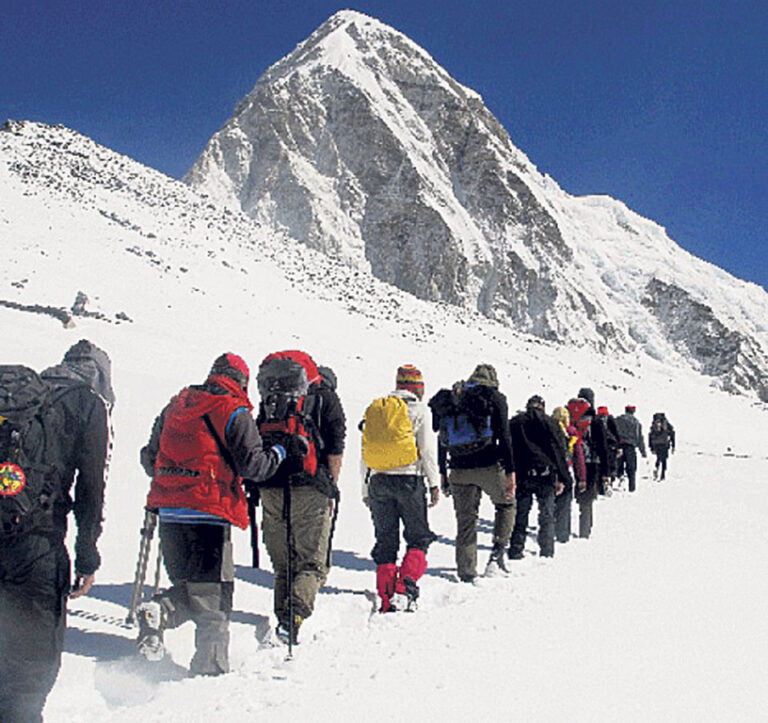KATHMANDU, May 4: Nepal is gaining popularity globally as an excellent destination for tourists to showcase the beauty of the Himalayas and experience expeditions. Nepal is home to eight of the world’s highest peaks over 8,000 meters above sea level, and Mount Everest is a particularly adventurous tourist destination.
In the Himalayan region, indigenous communities have enriched the beauty of tourist destinations through their lifestyle, authentic culture, language, food, customs, history, indigenous knowledge and traditions. Nepal’s tourist destinations are colored by the uniqueness of these indigenous communities. Therefore, to achieve sustainable tourism, experts suggest identifying and prioritizing the main contributors to preserving and protecting the true essence and beauty of tourist destinations.
Expert Ram Kumar Pandey suggested that mountains and the Himalayas should be seen as an opportunity rather than a problem.
“We have continued to pass on traditional cultural heritage as intangible heritage,” he said. He said that protecting and promoting our culture is not only the responsibility but also the right of every Nepali. This issue is guaranteed in Article 32(3) of the Constitution of Nepal as the right to language and culture, which states: “Every community residing in Nepal has the right to preserve and promote its language, script, culture and cultural civilization. It is stipulated that And heritage. ”
Expert Pandey believes that people living in mountainous regions have managed locally available resources sustainably as part of their tradition. However, rights-based issues have been ignored due to lack of access to mainstream state functions.
“In mountainous areas, a specific economic and social system has developed based on the geographical topography,” Pandey said, adding, “The development blueprint of lowlands cannot be implemented there, so the state has to develop demographic planning and We need to formulate policies.” It has characteristics suitable for mountainous areas. ”
Nepal’s economy develops through the tourism sector, which is the only sector that generates foreign exchange earnings without exporting goods and services. Furthermore, the main source of income in the tourism sector is mountaineering income.
According to the 2059 Mountaineering Regulations, there is a provision for a levy of 1.1 million rupees per foreign climber during the spring Everest climbing season, while Nepalis will have to pay 75,000 rupees per person. Foreign climbers spend at least 3 million to 10 million rupees to climb Everest.
Ang Tsering Sherpa, chief advisor of the Nepal Mountaineering Association, said, “With the small amount of money the state collects from climbers aiming to reach the highest peaks, indigenous communities receive basic necessities and equality to protect their rights.” “There is a possibility that we can secure access.” “Governments can also start programs to make them self-reliant by providing income-enhancing opportunities and training.”
According to the Department of Tourism (DoT), a total of 352 climbers, including 65 women and 287 men from 33 mountaineering teams, received permission to summit Everest this year. To date, climbers from 55 countries have registered to climb the world’s highest peaks, seeking a rush of adrenaline through adventurous climbing experiences.
A record number of 478 climbers obtained permits last year, resulting in Rs 564.4 million being collected from permits for climbing various mountains, including Everest. The DoT collected a revenue of Rs 760 crore last year. It is estimated that he is expected to earn an additional Rs 700 million this year, up from another Rs 500 million, as the spring season has just begun.
According to the 2021 Nepal Census Report of the Central Bureau of Statistics (now the National Bureau of Statistics), the total indigenous population of Nepal is 35.08%.
Mr. Sherpa added, “While politicians and parliamentarians are making speeches at national and international forums promoting adventure tourism through top-notch promotion and branding, there is no real person responsible for protecting the Himalayan ecosystem.” “The heroes remain in the shadows,” he added.
Even though Nepal has ratified ILO Convention No. 169 on Indigenous and Tribal Peoples and passed the United Nations Declaration on the Rights of Indigenous Peoples (UNDRIP) and the World Congress on Indigenous Peoples (WCIP) outcome document, the government has is denied. Indigenous. Implementation of laws, bills, ordinances and policies that are not in line with UNDRIP and ILO Convention No. 169 remains inadequate.
Despite the government’s commitment to promoting a sustainable tourism sector in its annual budget presentation, the situation and plight of local indigenous communities is not adequately addressed.
Sherpa said the effects of climate change in mountainous regions are causing glacial lakes to melt rapidly, leading to food insecurity and cultural threats to indigenous communities.
He added that development projects launched without social impact assessments in mountainous areas are causing displacement of indigenous communities, leading to alienation of their sense of belonging and identity. He argued that the lack of proper consideration is reducing opportunities to attract tourists through an authentic and unique lifestyle.
Experts said that sustainable tourism is essential for Nepal’s long-term economic sustainability, and it is only possible after prioritizing the rights of indigenous communities.
“The government should review the existing policies and development projects designed to promote sustainable tourism in Nepal,” Sherpa said, adding, “All of us should move from our homeland to the international stage. “We should be concerned about the rights of indigenous communities as we present ourselves.” ”

